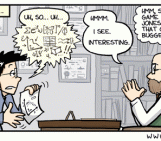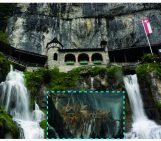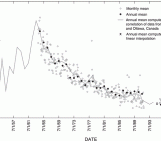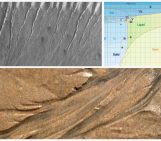
By David Litwin
At the American Geophysical Union Fall Meeting in December 2021, the AGU Hydrology Section Student Subcommittee (H3S) convened a townhall “Coming Together After Being Apart…” where the AGU Hydrology Section leadership were available for questions from the community, updates on current activities, and plans for future section initiatives. The conversation seemed important to share with hydrologists who might be interested in or affected by Section initiatives. Here I’ll summarize what was discussed and provide my perspective as an early career hydrologist.
The panelists for the townhall were Drs. Scott Tyler, Ana Barros, and John Selker, the past, present, and future presidents of the Hydrology Section respectively, Dr. Shirley Papuga, the section secretary, Dr. Thushara Gunda, a representative to the AGU Hydrology JEDI (justice, equity, diversity, and inclusion) committee, and Dan Myers, H3S chair-elect. Discussion focused primarily on section-level JEDI activities and progress and section awards, including the outstanding student presentation awards (OSPA).
The 2020 white paper published by H3S proposed forming a Hydrology Section JEDI standing committee, which met for the first time in fall 2021. The committee has 15 members from various career stages, and is currently chaired by Dr. Caitlyn Hall. In Fall 2021, the committee’s activities focused primarily on Fall Meeting, and discussion of how the committee will take feedback and communicate with section members. Currently suggested avenues include updates in the section newsletter, and a designated page on the AGU website where they will be able to take comments and suggestions. There was also a question about how the section will fund JEDI-related activities. The general consensus among the presidents (past, present, and future) was that funding is available, and the current need is for good ideas and initiatives to take on, including suggestions from community members (see links in the last paragraph). In the discussion of JEDI initiatives, some panelists emphasized the importance of education and exposure to Earth science and hydrology amongst students before college or even before high school. It was unclear exactly what section activities could address this. To me, it seemed this discussion lacked acknowledgement that getting students exposed is only half the challenge; retention and support of minoritized scientists and women in geoscience is often the limiting factor in diversity at the graduate or faculty level.
Section leadership were eager to discuss progress that was made by a recently created awards task force. Due to increasing competition for mid-career awards, the task force recommended the creation of the new Polubarinova-Kochina Hydrologic Sciences Mid-Career Award, after the Russian mathematician and groundwater scientist Pelageya Polubarinova-Kochina (1899-1999). This will be the section’s first award named after a woman. Also discussed were plans for additional awards for educational excellence and an award that could be given to teams of researchers.
One question from section members was how the section is addressing calls to diversify award recipients, in light of the Cryosphere Section’s decision not to send nominees to the AGU Fellows Committee. Leadership discussed recent work to reach out more broadly to identify scientists who would like to be nominated. For those who desire nomination, the section will then help find someone to nominate you. (Not sure where to start with nomination? Check out these tips!) Another question addressed the possibility of student and early-career involvement in the process of selecting award recipients. While there was some general discussion about removing the hierarchy of awards, in which one would need to attain one prize before being selected for (or involved in the selection of) the next, the current president was clear that awards should be given by people with experience, and that this would also avoid putting early career scientists in difficult positions with respect to senior scientists.
Lastly, there was a discussion of the OSPA. These awards give all participating students at the Fall Meeting an opportunity for feedback on their presentations, and enter them into the competition for recognition. This year the section decided to cancel the OSPA competition, while still allowing those judged to receive feedback. The decision was made after it became clear that there were not enough judges to make the competition fair—only 30% of participants received at least one judge. While some audience members felt that canceling the competition was unfair to students, leadership reasonably came to the conclusion that it was more unfair to many who wanted to participate in OSPA that the winner would be selected from the small pool of whomever happened to be judged. The state of OSPA seemed frustrating to many people – students and early career scientists attending the townhall emphasized the need for senior scientists to step up and be involved. While leadership acknowledged this, they also put some of the blame on AGU for creating a fundamentally unusable OSPA online interface. By the end of the discussion, the future of OSPA remained uncertain. All options seemed open, including a complete change in format for how the section recognizes excellent student research.
I’m a PhD candidate, and therefore still relatively new to the AGU community. From the discussion I learned a little more about how much of the section’s efforts are spent on awards and recognition, from section awards, to AGU fellowship, to OSPA. President-elect John Selker noted the same thing in a recent post on the AGU Connects discussion board: “we must acknowledge that we spend over half of our organizational energy in the process of assigning awards. I liken this to a cat following the spot of light from a laser: this is certainly not our primary mission (the mice -e.g. climate change- are on the loose), but the light dances on our egos and careers, affixing our attention.” At the same time, the student subcommittee, H3S, expends most of its efforts on providing resources for students and early career members of the section through blog posts, seminars, panel discussions, townhalls, and more. I wonder whether there is some further mission missing from the section’s goals at large. Are there initiatives that scientists beyond early career would like to see our societies take on, or resources they would like to see created? Or are awards expected to be the central activity? Perhaps the JEDI committee is the most recent demonstration that there is interest and desire for activities beyond awards. Where do you think the section’s future priorities should lie? If you have ideas, you don’t have to wait for this townhall to take place next year. Please share them with H3S, section leadership, or on the community discussion board.




